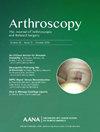外科医生进行多模式肩部注射可减少臂丛神经阻滞麻醉下关节镜袖带修复术后的反跳痛:前瞻性随机对照试验。
IF 4.4
1区 医学
Q1 ORTHOPEDICS
Arthroscopy-The Journal of Arthroscopic and Related Surgery
Pub Date : 2025-05-01
DOI:10.1016/j.arthro.2024.07.029
引用次数: 0
摘要
目的:比较在臂丛神经阻滞(ISBPB)麻醉下接受关节镜下肩袖修复术(ASRCR)的患者术后反跳痛的额外多模式肩部注射的效果:2023 年 4 月至 2023 年 12 月期间,对 67 名患者进行了单盲随机对照试验。注射组接受 40 mL 0.75% 罗哌卡因、20 mg 吗啡、1:200,000 肾上腺素和生理盐水,共计 100 mL。手术后,在肩胛上神经盲阻滞(25 毫升)和腋神经盲阻滞(25 毫升)的情况下,向肩峰下间隙注射(50 毫升)。对照组接受 100 毫升生理盐水。所有患者均使用静脉患者自控镇痛(IV-PCA)作为辅助镇痛。评估的主要结果是术后 12 小时的视觉模拟量表(VAS)疼痛评分,次要结果是反跳痛发生率和术后 0、2、4、8、24、36 和 48 小时的 VAS 疼痛评分。此外,还记录了静脉注射 PCA 中的芬太尼和镇痛抢救药物的用量、并发症和满意度:共纳入 67 例患者(注射组 32 例,对照组 35 例),平均年龄(61.1±9.0)岁。主要结果评估--12 小时后的 VAS 疼痛评分--注射组明显优于对照组(2.7±0.93 vs. 4.1±1.70,p):本研究发现,与对照组相比,在 ISBPB 麻醉下进行 ASRCR 期间的多模式肩关节注射能显著降低术后 12 小时的 VAS 疼痛评分,并减少反跳痛的发生率。术后 12 至 48 小时的疼痛程度持续降低。此外,注射组在术后 48 小时内减少了阿片类药物的用量,且未观察到并发症:证据级别:一级,随机对照试验。本文章由计算机程序翻译,如有差异,请以英文原文为准。
Rebound Pain After Arthroscopic Cuff Repair With Interscalene Brachial Plexus Block Anesthesia Is Reduced by Surgeon-Administered Multimodal Shoulder Injections: A Prospective Randomized Controlled Trial
Purpose
To compare the effects of additional multimodal shoulder injections on postoperative rebound pain in patients undergoing arthroscopic rotator cuff repair (ASRCR) under interscalene brachial plexus block (ISBPB) anesthesia.
Methods
A single-blind randomized controlled trial was conducted with 67 patients between April and December 2023. Patients undergoing ASRCR who received ISBPB anesthesia, rather than general anesthesia, with a minimum follow-up period of 48 hours were included. The injection group received 40 mL of 0.75% ropivacaine, 20 mg morphine, 1:200,000 epinephrine, and saline solution, totaling 100 mL. After surgery, the injection was administered to the subacromial space (50 mL) with blind suprascapular nerve block (25 mL) and blind axillary nerve block (25 mL). Control subjects received 100 mL of saline solution. Intravenous patient-controlled analgesia (IV-PCA) was used as adjuvant analgesia for all patients. The primary outcome was evaluated using the visual analog scale (VAS) pain score at 12 hours after surgery, with secondary outcomes of the incidence of rebound pain and VAS pain scores at 0, 2, 4, 8, 24, 36, and 48 hours postoperatively. Fentanyl in the IV-PCA and rescue analgesic amounts, complications, and patient satisfaction were recorded.
Results
Sixty-seven patients (32 in the injection group, 35 in the control group) with a mean age of 61.1 ± 9.0 years were included. The primary outcome assessment, VAS pain score at 12 hours, significantly favored the injection group (2.7 ± 0.93 vs 4.1 ± 1.70, P < .001). The incidence of rebound pain was 18.8% and 65.7% in the injection and control groups, respectively (18.8% vs 65.7%, P < .001). The injection group reported better VAS pain scores at 24, 36, and 48 hours and lower fentanyl use over the 48-hour postoperative period (P = .014). The use of rescue analgesics was similar between groups, and no complications were associated with multimodal shoulder injections. Satisfaction levels were similar in both groups.
Conclusions
The present study found that patients who underwent multimodal shoulder injections during ASRCR under ISBPB anesthesia had significantly lower VAS pain scores at 12 hours postoperatively and reduced incidence of rebound pain compared with the control group. Pain levels were consistently lower from 12 to 48 hours postoperatively. Additionally, the injection group had reduced opioid consumption within the first 48 hours postoperatively, with no complications observed.
Level of Evidence
Level I, randomized controlled trial
求助全文
通过发布文献求助,成功后即可免费获取论文全文。
去求助
来源期刊
CiteScore
9.30
自引率
17.00%
发文量
555
审稿时长
58 days
期刊介绍:
Nowhere is minimally invasive surgery explained better than in Arthroscopy, the leading peer-reviewed journal in the field. Every issue enables you to put into perspective the usefulness of the various emerging arthroscopic techniques. The advantages and disadvantages of these methods -- along with their applications in various situations -- are discussed in relation to their efficiency, efficacy and cost benefit. As a special incentive, paid subscribers also receive access to the journal expanded website.

 求助内容:
求助内容: 应助结果提醒方式:
应助结果提醒方式:


